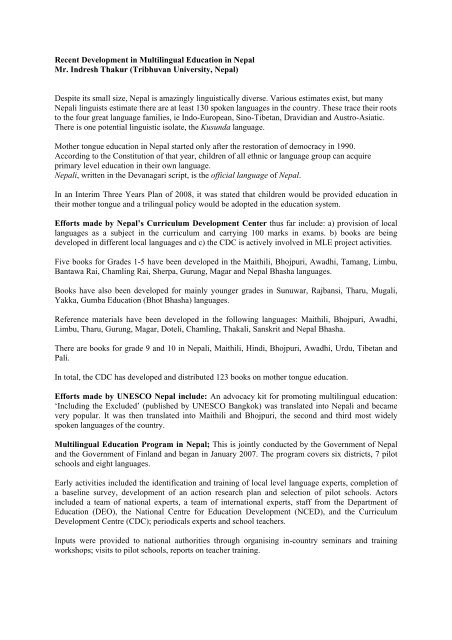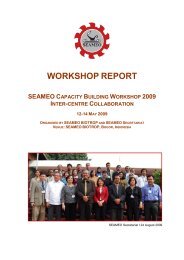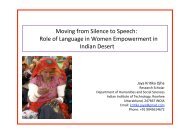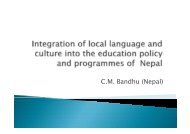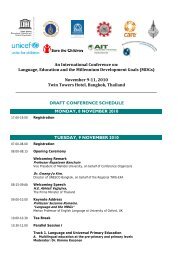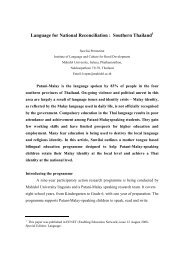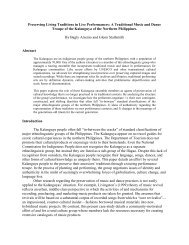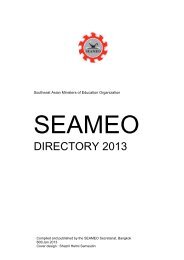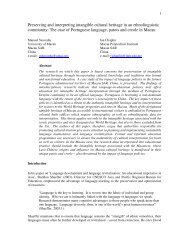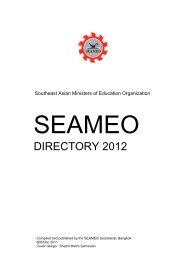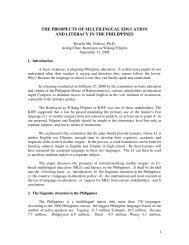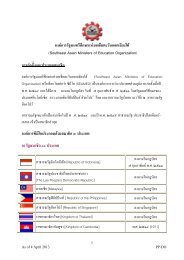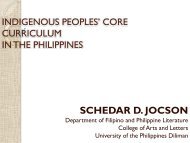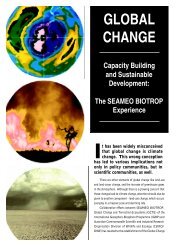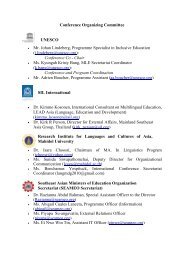Recent Development in Multilingual Education in Nepal ... - SEAMEO
Recent Development in Multilingual Education in Nepal ... - SEAMEO
Recent Development in Multilingual Education in Nepal ... - SEAMEO
You also want an ePaper? Increase the reach of your titles
YUMPU automatically turns print PDFs into web optimized ePapers that Google loves.
<strong>Recent</strong> <strong>Development</strong> <strong>in</strong> Multil<strong>in</strong>gual <strong>Education</strong> <strong>in</strong> <strong>Nepal</strong><br />
Mr. Indresh Thakur (Tribhuvan University, <strong>Nepal</strong>)<br />
Despite its small size, <strong>Nepal</strong> is amaz<strong>in</strong>gly l<strong>in</strong>guistically diverse. Various estimates exist, but many<br />
<strong>Nepal</strong>i l<strong>in</strong>guists estimate there are at least 130 spoken languages <strong>in</strong> the country. These trace their roots<br />
to the four great language families, ie Indo-European, S<strong>in</strong>o-Tibetan, Dravidian and Austro-Asiatic.<br />
There is one potential l<strong>in</strong>guistic isolate, the Kusunda language.<br />
Mother tongue education <strong>in</strong> <strong>Nepal</strong> started only after the restoration of democracy <strong>in</strong> 1990.<br />
Accord<strong>in</strong>g to the Constitution of that year, children of all ethnic or language group can acquire<br />
primary level education <strong>in</strong> their own language.<br />
<strong>Nepal</strong>i, written <strong>in</strong> the Devanagari script, is the official language of <strong>Nepal</strong>.<br />
In an Interim Three Years Plan of 2008, it was stated that children would be provided education <strong>in</strong><br />
their mother tongue and a tril<strong>in</strong>gual policy would be adopted <strong>in</strong> the education system.<br />
Efforts made by <strong>Nepal</strong>’s Curriculum <strong>Development</strong> Center thus far <strong>in</strong>clude: a) provision of local<br />
languages as a subject <strong>in</strong> the curriculum and carry<strong>in</strong>g 100 marks <strong>in</strong> exams. b) books are be<strong>in</strong>g<br />
developed <strong>in</strong> different local languages and c) the CDC is actively <strong>in</strong>volved <strong>in</strong> MLE project activities.<br />
Five books for Grades 1-5 have been developed <strong>in</strong> the Maithili, Bhojpuri, Awadhi, Tamang, Limbu,<br />
Bantawa Rai, Chaml<strong>in</strong>g Rai, Sherpa, Gurung, Magar and <strong>Nepal</strong> Bhasha languages.<br />
Books have also been developed for ma<strong>in</strong>ly younger grades <strong>in</strong> Sunuwar, Rajbansi, Tharu, Mugali,<br />
Yakka, Gumba <strong>Education</strong> (Bhot Bhasha) languages.<br />
Reference materials have been developed <strong>in</strong> the follow<strong>in</strong>g languages: Maithili, Bhojpuri, Awadhi,<br />
Limbu, Tharu, Gurung, Magar, Doteli, Chaml<strong>in</strong>g, Thakali, Sanskrit and <strong>Nepal</strong> Bhasha.<br />
There are books for grade 9 and 10 <strong>in</strong> <strong>Nepal</strong>i, Maithili, H<strong>in</strong>di, Bhojpuri, Awadhi, Urdu, Tibetan and<br />
Pali.<br />
In total, the CDC has developed and distributed 123 books on mother tongue education.<br />
Efforts made by UNESCO <strong>Nepal</strong> <strong>in</strong>clude: An advocacy kit for promot<strong>in</strong>g multil<strong>in</strong>gual education:<br />
‘Includ<strong>in</strong>g the Excluded’ (published by UNESCO Bangkok) was translated <strong>in</strong>to <strong>Nepal</strong>i and became<br />
very popular. It was then translated <strong>in</strong>to Maithili and Bhojpuri, the second and third most widely<br />
spoken languages of the country.<br />
Multil<strong>in</strong>gual <strong>Education</strong> Program <strong>in</strong> <strong>Nepal</strong>; This is jo<strong>in</strong>tly conducted by the Government of <strong>Nepal</strong><br />
and the Government of F<strong>in</strong>land and began <strong>in</strong> January 2007. The program covers six districts, 7 pilot<br />
schools and eight languages.<br />
Early activities <strong>in</strong>cluded the identification and tra<strong>in</strong><strong>in</strong>g of local level language experts, completion of<br />
a basel<strong>in</strong>e survey, development of an action research plan and selection of pilot schools. Actors<br />
<strong>in</strong>cluded a team of national experts, a team of <strong>in</strong>ternational experts, staff from the Department of<br />
<strong>Education</strong> (DEO), the National Centre for <strong>Education</strong> <strong>Development</strong> (NCED), and the Curriculum<br />
<strong>Development</strong> Centre (CDC); periodicals experts and school teachers.<br />
Inputs were provided to national authorities through organis<strong>in</strong>g <strong>in</strong>-country sem<strong>in</strong>ars and tra<strong>in</strong><strong>in</strong>g<br />
workshops; visits to pilot schools, reports on teacher tra<strong>in</strong><strong>in</strong>g.
Outputs <strong>in</strong>cluded; awareness raised <strong>in</strong> teachers of the pilot schools <strong>in</strong> us<strong>in</strong>g mother tongue (MT) <strong>in</strong><br />
education; technical tra<strong>in</strong><strong>in</strong>g <strong>in</strong> preparation of texts <strong>in</strong> mother tongue; MT reference books and<br />
guidel<strong>in</strong>es; an MLE teacher tra<strong>in</strong><strong>in</strong>g manual.<br />
Challenges for MLE; It is still often only a ‘slogan’. There is a lack of clarity <strong>in</strong> the current policies,<br />
ie whether there is a bil<strong>in</strong>gual or multil<strong>in</strong>gual approach. There is a lack of knowledge and skills <strong>in</strong><br />
terms of curriculum and textbook developments; a lack of teachers <strong>in</strong> many languages, and a lack of<br />
script for many languages. There is little fund<strong>in</strong>g for develop<strong>in</strong>g and distribut<strong>in</strong>g curriculum and<br />
textbooks. Communities are reluctant to contribute to the development of MLE (the local language is<br />
seen as not beneficial for gett<strong>in</strong>g a job).<br />
In conclusion, government policy should be more flexible. Communities should be supported to be<br />
<strong>in</strong>volved <strong>in</strong> the development of teach<strong>in</strong>g materials and promot<strong>in</strong>g local languages both academically<br />
and managerially; there needs to be much more work <strong>in</strong> terms of curriculum and textbook<br />
development, language teacher development, and provision and dissem<strong>in</strong>ation of all k<strong>in</strong>ds of<br />
resources.


